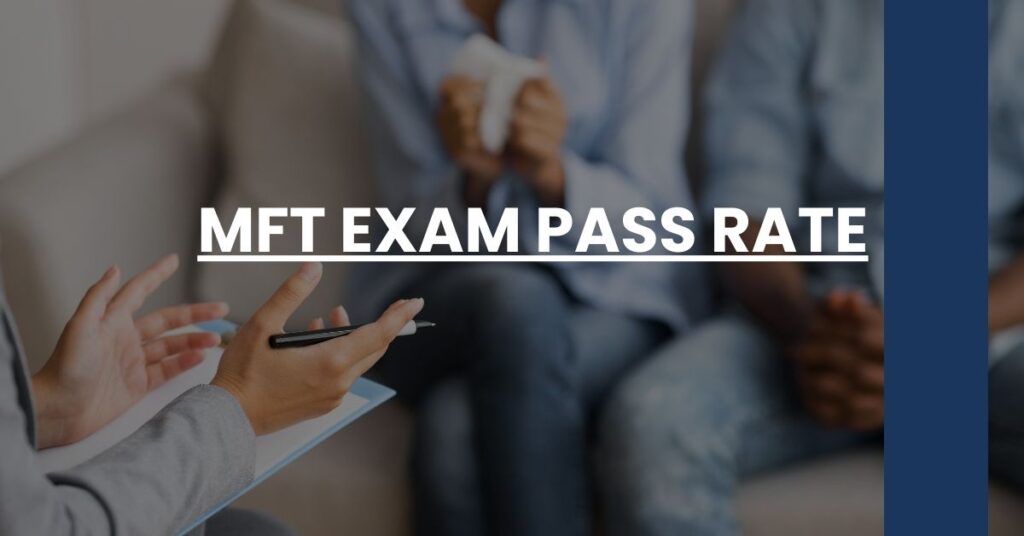The MFT Exam, a critical step for licensure in marriage and family therapy, has varying pass rates that can reflect the quality of academic programs and effectiveness of test preparation. Pass rates fluctuate but generally reveal higher success in specific regions like the Northeast and Midwest. Strategies such as attending accredited MFT programs and utilizing specialized test prep can significantly improve chances of passing.
In this article, you’ll uncover:
- How historical pass rate trends inform current expectations
- The significant impact of test preparation on exam results
- Accredited program successes, with examples like a 100% pass rate at the University of Southern Mississippi
Knowing the MFT exam pass rate helps you set realistic goals and tailor your study approach for the best chance at success.
- Understanding the MFT Exam
- Demystifying the Pass Rate
- Historical Perspective on MFT Exam Pass Rates
- Factors Influencing MFT Exam Success
- Interpreting Pass Rate Data
- Regional Variations in Pass Rates
- How Test Prep Programs Affect Pass Rates
- Strategies for Improving Your Chances of Passing
- The Role of Accredited MFT Programs on Exam Outcomes
- Conclusion: What the MFT Exam Pass Rate Means for You
Understanding the MFT Exam
If you’re on the path to becoming a licensed marriage and family therapist, you’ve likely encountered the MFT Exam as a pivotal milestone. This comprehensive testing process evaluates your understanding and application of critical therapeutic concepts and practices relevant to couples and family therapy.
The exam, formally called the Examination in Marital and Family Therapy, is developed by the Association of Marital & Family Therapy Regulatory Boards (AMFTRB) and administered by the Professional Examination Service (PES). It’s designed to assess a candidate’s competency in critical areas like:
- Assessment and diagnosis
- Designing and conducting treatment
- Evaluating ongoing processes
- Ethical, legal and professional standards
As a robust measure of your readiness, the MFT Exam ensures that only qualified individuals gain the title of licensed marital and family therapists. Knowing the ins and outs of this exam is your first step towards successful licensure.
Demystifying the Pass Rate
When we talk about the MFT exam pass rate, we’re looking at the percentage of candidates who successfully meet or exceed the score threshold to pass. This figure gives you a snapshot of how challenging the exam might be based on others’ experiences.
However, keep in mind that this rate is influenced by several factors:
- The diversity of test-takers’ educational backgrounds
- Variability in the content of exam preparatory resources
- Changes in the exam content outline
- Psychological factors such as test anxiety
Understanding these elements can help you put the MFT exam pass rate into context as you prepare for your own test-taking experience.
Historical Perspective on MFT Exam Pass Rates
Grasping the historical trends in MFT exam pass rates might offer crucial insights into the exam’s evolution. For instance, if you notice a consistent upward trend, this could reflect the increasingly effective preparation strategies or improvements in education programs.
Conversely, a sudden drop in pass rates, such as what occurred in California between the fourth quarter of 2016 and the first quarter of 2017, might signal a change in the exam’s difficulty level or alterations in the regulatory standards. These historical fluctuations can be pivotal in understanding the landscape you’re stepping into and gearing up your preparation accordingly. A closer look at these trends might reveal patterns and precipitating factors worth considering.
Factors Influencing MFT Exam Success
Your success on the MFT Exam hinges on various elements that are both within and beyond your control. Some of the prominent factors include:
- Academic preparedness: Are you well-versed in the core subjects the exam will cover?
- Test complexity: How do you tackle complex questions under time pressure?
- Demographics: Research has shown that age, ethnicity, and primary language can influence performance.
To optimize your chances of success, identifying your strengths and weaknesses in relation to these influencing factors is critical. By doing so, you position yourself to strategically address potential hurdles and enhance your readiness for the exam.
Interpreting Pass Rate Data
Analyzing MFT exam pass rate data is more than just perusing numbers; it’s about understanding what they imply for your test preparation. High pass rates might indicate that a particular academic program effectively equips its students, or that available resources are aligning well with exam content.
On the flip side, lower pass rates do not necessarily denote an insurmountable exam. They may reflect the need for updated study materials or that candidates should consider altering their study techniques. The correct interpretation of this data empowers you to make informed decisions regarding your preparation journey. It’s a stepping stone to answering — what does this mean for you, specifically, as a prospective test-taker?
With this better understanding of the MFT exam landscape, you’re equipped to move on to a deeper exploration of how location might play a role in these statistics.
Regional Variations in Pass Rates
When you dissect the MFT exam pass rate, you might notice intriguing variations across different regions. It’s not uncommon to see higher success rates in the Northeast and Midwest, according to findings by the Association of Social Work Boards (ASWB). But why is this the case?
Several factors contribute to regional differences:
- Educational standards: Some regions may have schools with more rigorous academic curricula.
- State-specific regulations: Varying licensure requirements across states may impact how well candidates prepare.
- Access to resources: The availability of prep courses and study materials could be uneven, influencing preparedness.
These disparities suggest that where you are could affect your odds of passing. If the MFT exam pass rate in your area is lower, consider which local factors may be playing a role and how you might overcome them. You can check out more on this at ASWB’s examination pass rates by state and province.
How Test Prep Programs Affect Pass Rates
A significant boost to your chances of nailing the MFT exam can come from participating in a test prep program—but not all programs are created equal. Programs like the Laugh to Licensure MFT, which leverage brain-based learning techniques, tout remarkable effects on exam readiness and, consequently, pass rates.
Here’s how good test prep can make a difference:
- Targeted learning: Focusing on exam-specific content maximizes efficiency.
- Test-taking strategies: Learning how to approach different question types can be game-changing.
- Confidence boost: Familiarity with the exam format can significantly reduce anxiety.
Make sure to evaluate the test prep options available to you. A robust program that’s attuned to the complexities of the MFT exam could be a worthy investment in your future success. Find out how test prep contributes to better outcomes by exploring resources like Therapy That Works Institute.
Strategies for Improving Your Chances of Passing
Moving on from the influence of test-prep programs, let’s dive into a variety of strategies you can adopt to elevate your probability of passing the MFT exam:
- Thoroughly understand the content areas: Make sure you are well-versed in all domains the exam will cover.
- Practice under exam conditions: Simulate the test environment to get accustomed to the pressure.
- Manage your time wisely: Develop a study schedule that allows for consistent, focused preparation.
- Seek feedback: Utilize practice exams to pinpoint areas needing improvement.
By incorporating these strategies into your study regimen, you give yourself a considerable edge. It’s about being proactive in your approach while consistently fine-tuning your knowledge and skills.
The Role of Accredited MFT Programs on Exam Outcomes
As you consider various avenues to increase your MFT exam pass rate potential, don’t underestimate the power of a quality educational program. Accredited MFT programs, such as those recognized by the Commission on Accreditation for Marriage and Family Therapy Education (COAMFTE), often provide rigorous training that translates into higher pass rates.
Consider the University of Southern Mississippi’s MFT program, which reports a 100% pass rate on the National MFT Exam for six consecutive years. This impressive statistic underscores the value of an accredited background. These programs offer comprehensive coursework, practicum experiences, and faculty support that are all instrumental to achieving success on the exam. To learn more, visit the University of Southern Mississippi’s MFT program page.
Conclusion: What the MFT Exam Pass Rate Means for You
Understanding the intricacies behind the MFT exam pass rate is more than an academic exercise—it’s a strategic step in your journey toward becoming a licensed marriage and family therapist. Pass rates are a beacon, providing insight into how prepared you need to be to not just pass, but excel.
Your takeaway should be that while these statistics are informative, they are not deterministic. With the right preparation, mindset, and resources—whether it be an accredited MFT program or a specialized test prep course—you can significantly influence your individual outcome.
Remember, your path to passing the MFT exam is unique, but it is paved with the experiences of those who’ve walked it before. Draw on the historical data, embrace the power of test preparation, hone your test-taking strategy, and align yourself with an accredited educational program that fits your needs. These steps will help you become part of a promising MFT exam pass rate statistic—the kind that inspires future test-takers to reach for their own success.
MFT exam pass rate data reveals trends and challenges, aiding candidates in strategizing their study approach for success.

